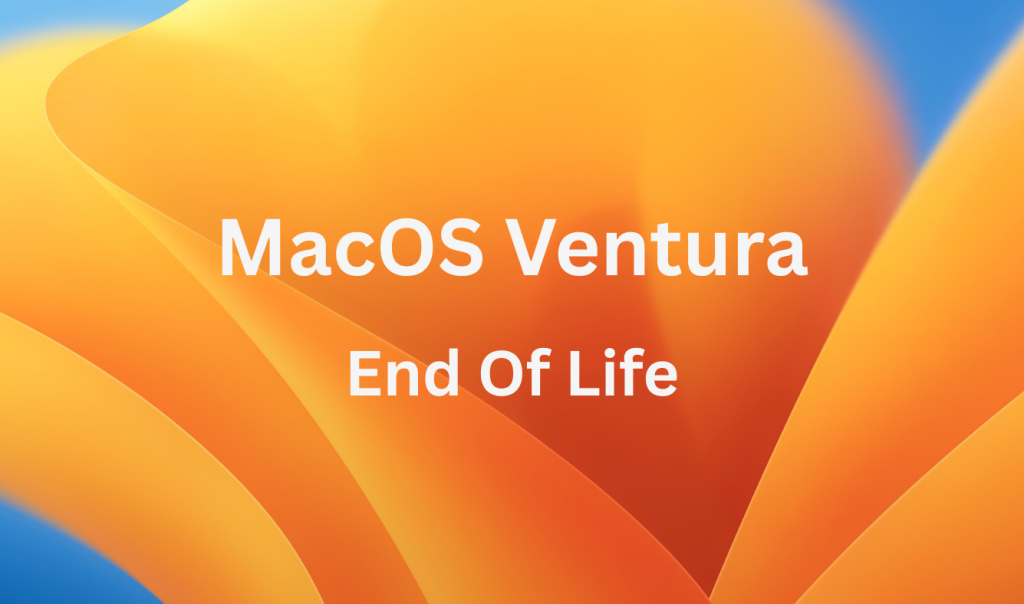Technology never stands still. As Microsoft prepares to retire Windows 10, Apple is also making major changes in its macOS lineup. With the release of MacOS Tahoe (version 26) in September 2025, macOS Ventura (version 13) has now reached its end-of-life stage.
For businesses that rely on Macs, this is more than just a software update. It’s a turning point that requires planning, investment, and a focus on security. Let’s explore what macOS Ventura’s end of support means, the risks of continuing to use it, and how your organisation can prepare for the transition.
If your organisation still runs Ventura on Macs, now is the time to plan your upgrade strategy. In this article, we’ll explain what MacOS 13 Ventura End of Life means, the risks of sticking with unsupported software, and how your business can prepare for a smooth transition.

What does “End of Life” mean for MacOS Ventura?
Apple typically supports the three most recent macOS versions with security updates and patches. With macOS Tahoe (26) joining Sonoma (14) and Sequoia (15) in the active support cycle, Ventura has fallen out of Apple’s window.
While Apple has not announced a precise end date, industry analysts and IT professionals expect support to stop by 30th November 2025. After that point, Ventura devices will no longer receive:
Security updates and vulnerability patches
Technical support from Apple
Bug fixes or stability improvements
In short: Ventura systems will be frozen in time, leaving them increasingly vulnerable.
What happens if you stay on Ventura?
From December 2025 onwards, businesses still running macOS Ventura face several risks:
Security exposure – Without patches, new cyber threats can exploit vulnerabilities, making Ventura devices prime targets.
Compliance failures – Standards such as Cyber Essentials, ISO 27001, and GDPR require supported systems. Unsupported macOS versions can cause compliance gaps.
Application issues – As developers update apps for Sonoma, Sequoia, and Tahoe, Ventura users may experience compatibility failures.
Performance decline – Older systems running unsupported software may suffer slowdowns and instability.
Operational disruption – Sectors with high Mac usage—such as education, healthcare, retail, and creative industries—may see productivity impacted by outdated technology.
Key considerations for upgrading macOS
If your organisation is still using Ventura, upgrading is no longer optional. Here’s what you need to consider:
1. Hardware compatibility
Apple generally supports devices for about seven years from their release date. If your Macs were purchased in 2018 or earlier, they may not support Sonoma, Sequoia, or Tahoe. In these cases, a hardware refresh may be the best option.
2. Application and workflow testing
Before rolling out a new macOS version across your business, test critical applications, plugins, and integrations (such as CRM systems) to avoid workflow disruption.
3. Security and compliance alignment
Ensure your upgrade strategy keeps your systems compliant with your business’s cybersecurity policies and industry regulations. Outdated systems can put sensitive customer and business data at risk.
4. Planning for downtime and training
Even well-managed upgrades require preparation. Schedule time for deployment, testing, and user training so your teams adapt smoothly to the new environment.
What’s new in macOS Tahoe?
Launched on 15th September 2025, macOS Tahoe brings a refreshed design and features designed to improve productivity and security.
Highlights include:
A modern “Liquid Glass” interface for smoother, more intuitive navigation
Enhanced cross-device integration for users working across iPhone, iPad, and Mac
Stronger privacy and security controls built into the OS
Performance improvements optimised for newer Mac hardware
While these changes offer benefits, they may also affect app behaviour. That’s why testing is key before a full business rollout.
Don’t let outdated technology hold you back
Continuing to run Ventura beyond its support window could expose your business to unnecessary risk. Unsupported devices become a liability—slowing productivity, complicating compliance, and opening doors to cyber threats.
For Macs more than seven years old, replacing hardware is often more cost-effective than trying to run unsupported software. Staying within Apple’s recommended support window ensures you benefit from the latest features, highest performance, and strongest security.
The bottom line
The End of Life for macOS Ventura is not just a technical detail — it’s a business-critical moment. Unsupported operating systems bring higher risks, compliance issues, and potential costs. Now is the time for businesses to take stock of their Apple estate, plan upgrades, and ensure their teams remain secure and productive.
Contact Creative Networks Today
At Creative Networks, we help organisations manage Apple devices with the same rigour as Windows environments.
Our services include:
MacOS upgrade planning and rollout across entire fleets
Hardware audits and refresh strategies to ensure long-term support
Security and compliance alignment with frameworks like Cyber Essentials and ISO 27001
Apple device lifecycle management, from procurement to disposal
Ongoing IT support for Mac-powered businesses
Contact Creative Networks today to discuss your upgrade strategy and keep your business secure as macOS Ventura reaches end of life.




